
Ponte Vecchio is closed-spandrel segmental arch bridge in Florence, Italy. It spans Arno River, it is made of stone and it is placed at the location where Romans built first bridge in Florence before 994 AD when it was mentioned for the first time.
Flood destroyed the bridge for the first time in 1117 and after reconstruction again in 1333 only for it to be rebuilt in today’s shape in 1345. It is not known who is the designer of today’s bridge but it is believed that it is Taddeo Gaddi or Neri di Fioravanti.
Venice, the capital of the Veneto region, has a population of more than 270,000, according to the latest census (2004). It is located in the north-east of Italy on numerous small islands in the Venetian Lagoon.
The "City of Bridges", as it is usually called, stretches along the mouths of the Po and the Piave rivers.
Out of the 270,000 inhabitants, about 62,000 live in the historical center, or city of Venice, about 176,000 live in the mainland or "Terraferma", behind the lagoon, in locations like Mestre and Marghera, and all others live on islands throughout the lagoon (there are about 100 islands around Venice).
Also known as a famous place for sweethearts, lovers, artists and poets, Venice is a magical city, which stretches across numerous small islands. It is often refered to as the city of "gondole", which are the means of transportation used to cross the numerous canals passing through the city.
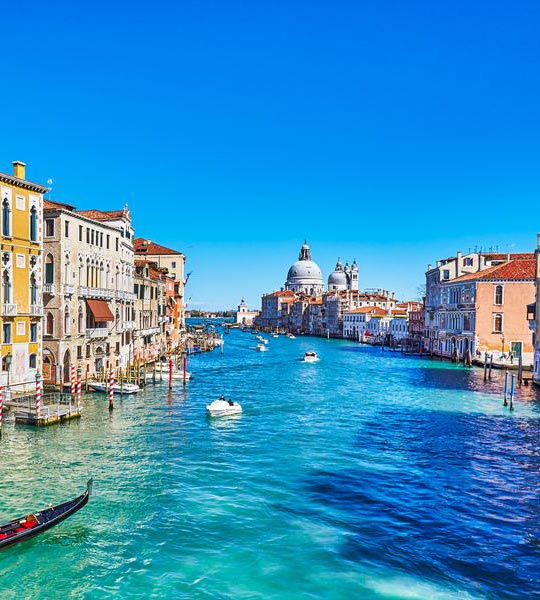
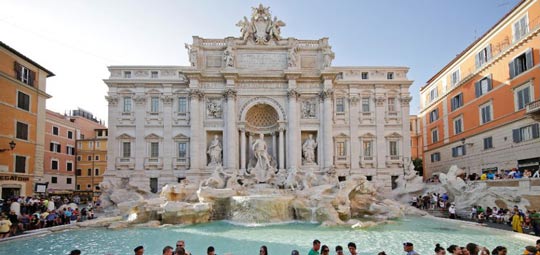
The Trevi Fountain is the most famous and the largest fountain in Rome. It has a width of 20 meters and a height 30 meters. It is situated at the Piazza di Trevi or the Trevi square. It marks the end point of the three road junction that leads to Acqua Vergine (previously known as Aqua Virgo), one of the aqueducts which once served as the water source of the Ancient Rome.
More than just a garden, it is a place of historical importance for Florence
More than a garden, more than just a “green lung” in Florence, the Boboli gardens are one of the greatest open-air museums in Florence that embraces another site of culture in Florence, the Pitti Palace. The park hosts centuries-old oak trees, sculptures, fountains and offers peaceful shelter from the warm Florentine sun in summer, the beautiful colors of the changing foliage in the fall and smells of blooming flowers in the spring. The Boboli gardens are a spectacular example of "green architecture" decorated with sculptures and the prototype which inspired many European Royal gardens, in particular, Versailles.
Its creation and development spans four hundred years, from the 15th and 19th centuries. The original fields and gardens were laid out behind Santa Felicita in the Oltrarno by the Borgolo family, the name from which Boboli is thought to derive, and were bought in 1418 by Messer Luca Pitti. In 1549, the property was purchased by Cosimo I's wife Eleonora di Toledo, and was greatly enlarged to became the Medici family's new city residence.


Cinque Terre is the name of a district that encompasses five glorious towns, where small houses are surrounded by lush nature. Visitors to this district will be fascinated by the beauty of these five small villages, namely: Manarola, Riomaggiore, Corniglia, Vernazza and Monterosso al Mare. The inhabitants of Cinque Terre benefite not only from its pristine waters, but from its natural environment, where wild nature is interspersed with vineyards, olive groves and citrus orchards, creating a precious bond between man, his traditions and this breathtaking stretch of coast.
The Leaning Tower of Pisa is the piazza’s crowning glory. Although only a third as high as the Washington Monument, it was a miracle of medieval engineering, probably the tallest bell towers in Europe. With 207 columns ranged around eight stories, Tower of Pisa looks like a massive wedding cake knocked precariously askew by a clumsy giant guest.
The construction of Tower of Pisa began in August 1173 and continued for about 200 years due to the onset of a series of wars. Till today, the name of the architect is a mystery. Leaning Tower of Pisa and CathedralThe leaning Tower of Pisa was designed as a circular bell tower that would stand 185 feet high. It is constructed of white marble.
The tower has eight stories, including the chamber for the bells. Leaning-Tower of Pisa. The bottom story consists of 15 marble arches. Each of the next six stories contains 30 arches that surround the tower.
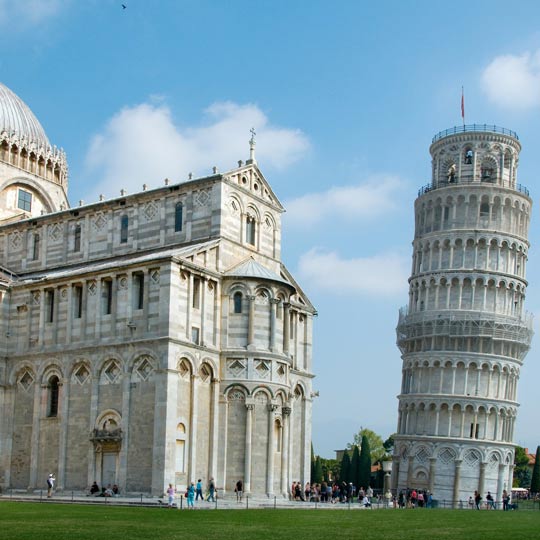
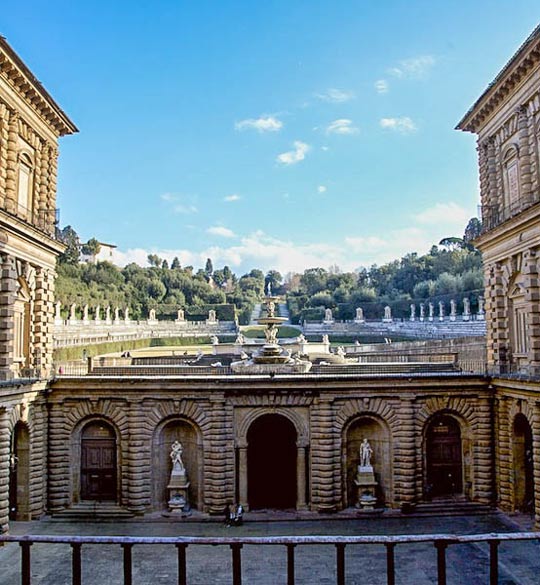
The palace, which houses several important museums, was built in the second half of the 15th century probably on a project of Filippo Brunelleschi for Luca Pitti, but was unfinished at his death in 1472. The original building, formed by two floors and the ground floors, with only five windows on each tloor, was purchased in 1550 by Eleonora da Toledo, the wife of the Grand Duke Cosimo I de'Medici, thus becoming the official residence of the family. For this reason it was widened and changed, in 1560 by Bartolomeo Ammannati and at the beginning of the 17th century by Giulio and Alfonso Parigi. The lather two architects gave the facade its present day aspect, with the only exception of the two lateral projecting pavilions that were built in the age of the Lorraine family and completed during the first half of the 19th century by Paoletti and Poccianti, who also built the Palazzina della Meridiana, added on to the rear section of the palace Downlooking the garden.
Most of the internal decoration was also executed during the 17th century by Giovanni da San Giovanni,Pietro da Cortona, il Volterrano, Antonio Domenico Gabbiani and Sebastiano Ricci.
As regards the domestic life inside the palace, we know that it was the home of several components of the family who were distributed in different private apartments. The rooms on the left wing belonged to the Grand Duke, while those on the right side were used by the heir. The lateral wings housed the apartments of their wives. The rooms on the second floor contained the large library, while the side rooms were used for the children. The left side on the ground floor housed the apartment that the Grand Duke used in summer.
Today, the palace and the Boboli gardens house the Palatine Gallery, the Silver Museum, the Museum of Modern Art, the Costume Gallery, the Porcelain Museum and the Museum of Carriages.
The National Museum has its setting in one of the oldest buildings in Florence that dates back to 1255. Initially the headquarters of the Capitano del Popolo (Captain of the People) and later of the Podestà, the palace became, in the sixteenth century, the residence of the Bargello that is of the head of the police (from which the palace takes its name) and was used as prison during the whole 18th century. Its walls witnessed important episodes of civic history. It was the meeting place of the Council of the Hundred in which Dante took part. It wituessed sieges, fires, executions, the most famous perhaps being that of Baroncelli, involved in the Pazzi plot against the Medici, which Leonardo also witnessed. During the 14th and 15th century, the palace was subjected to a series of alterations and additions, still preserving its harmonious severity, best seen in the beautiful courtyard, the balcony and the large hall on the first floor.
The building's use as National Museum began in the mid-19th century. Today it is the setting for works of sculpture, mainly from the grand ducal colleotions, and for many examples of "minor" Gothic decorative arts.
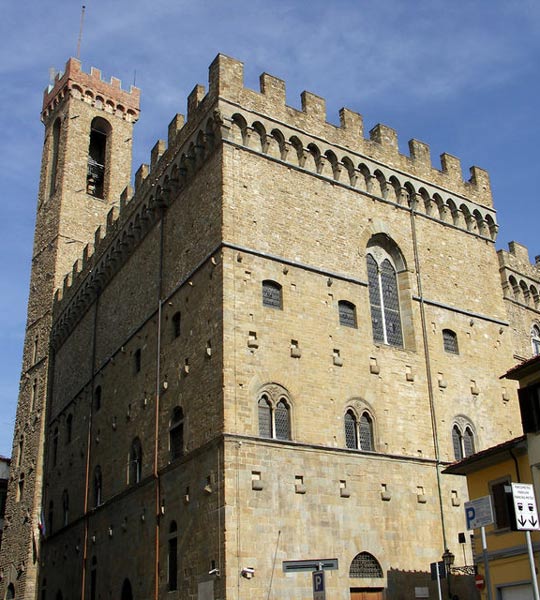
The large 14th century hall on the first floor displays some works by Donatello (1386-1466) including the early marble David, the St. George moved to this location from the niche in Orsammichele, the more mature and ambiguous bronze David, the Atys. and the Marzocco, originally installed on the battlements of Palazzo Vecchio. The works of the master are surrounded by the most delicate works of his pupils Desiderio da Settignano (c. 1430-1464) and Antonio Rossellino (c. 1427-1479). The collection also includes the two panels entered by Lorenzo Ghiberti and Filippo Brunelleschi for the Baptistery door competition of 1401. The Renaissance repertoire comprises the glazed terracottas by Luca della Robbia (c. 1400 - 1482) that include a very extraordinary group of Madonna with Child.
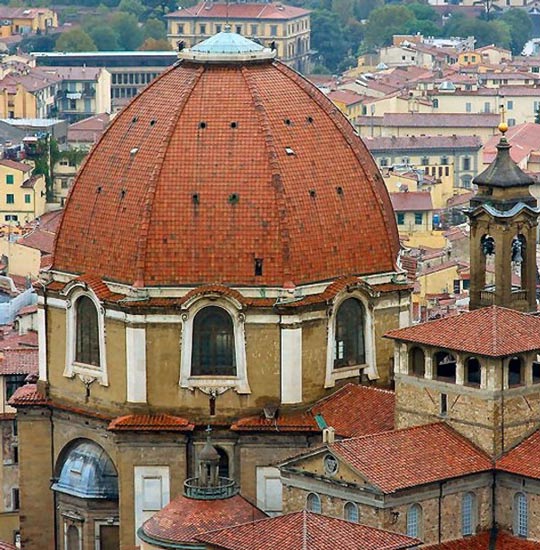
San Lorenzo is one of the most significant Renaissance churches in Florence; the story of its construction witnesses and testifies to the fortunate rise of the Medici family. The basilica stands on the site of one of the oldest churches in Florence which dates to the 4th century and was rebuilt on Romanesque canons in the 11th century. The first project to enlarge the Romanesque church dates to the second decade of the 15th century: it was commissioned from Filippo Brunelleschi by Giovanni de’ Medici, father of Cosimo the Elder and founder of the Medici dynasty. Work began in the area of the transept where a modern, raised choir was planned, along with square chapels in place of the old Romanesque apse. Brunelleschi’s more ambitious project to totally renew the building was put off and only realised in the second half of the 15th century, though with considerable modifications compared to the original concept. The basilica space was, in any event, organised according to the laws of geometry, while a well-calculated use of proportion joined all of the architectural elements, thus offering a significant example of the close relationship between science and art.
The Piazzale Michelangelo was built on the hills located south of the Florence's historic center following the design of the architect Giuseppe Poggi. In 1869 Florence was the capital of Italy in this period, the whole city underwent an intense urban renewal, the "lungarni" (riverside walkways following the Arno) were created; on the right side replacing the walls of the 14th century the bypass (Viali di Circonvallazione) was opened and to the left side a panoramic tree-lined street of 8 km, currently called Viale dei Colli, in which top was constructed the Piazzale Michelangelo, as a panoramic terrace on the city. From 1890 to 1935, this street was used by the tram tracks of the Chianti that connected Florence with Greve in Chianti and San Casciano Val di Pesa.
In 1873 a copy of Michelangelo's David was taken to the square with the help of nine pairs of oxen. This monument occupies a privileged position, observing the city from above as a guard attentive to all the beauties that the city of Florence offers. This square was dedicated to the great Renaissance artist Michelangelo and the copy of the David was located in the center of the square next to the four allegories of the Medici Chapels of San Lorenzo. Poggi also designed the lodge in neoclassical style as a museum for the works of Michelangelo, but this museum was never built and currently houses a panoramic restaurant.

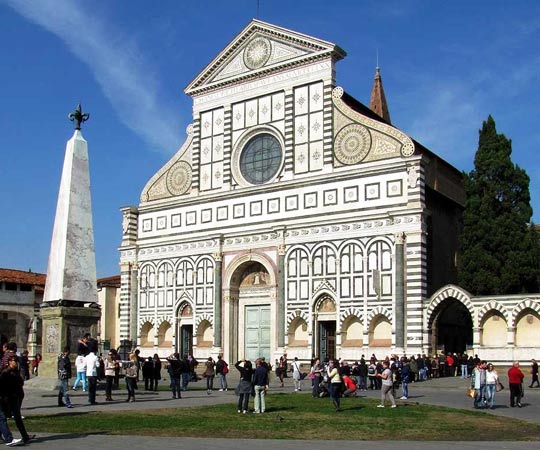
In 1219 twelve Dominican friars led by Fra Giovanni da Salerno came from Bologna and two years later obtained as their Florentine dwelling the church of Santa Maria delle Vigne, outside the city walls. The much larger church we see today was begun in 1279 to a design by two Dominican converses, Fra Sisto and Fra Ristoro, and was almost concluded with its adjacent convent by the middle of the 14th century.
Its internal structure resembles that of Cistercian gothic churches, the nave being separated from the aisles by wide bays and covered with gothic vaulting. Among the first works of art to reach the church was Duccio’s Maestà (1285), known as the ‘Rucellai Madonna’, which is now in the Uffizi; the Crucifix documented inside the church in 1312 was painted by the young Giotto.
The major 14th-century decorative schemes that have come down to us date from the years after the Plague of 1348. In the left transept, between 1350 and 1357, Nardo di Cione frescoed the walls of the Strozzi Chapel with the Last Judgement, Hell, and Paradise; the stained glass is also by Nardo. On the altar the panel, signed and dated 1357, with Christ giving the Keys to St. Peter and a Book to St. Thomas Aquinas, with the Madonna, St. John the Baptist and other Saints, and its predella, are the work of Nardo’s brother, Andrea di Cione, known as Orcagna (signed and dated 1357). Between 1367 and 1369 Andrea di Bonaiuto frescoed the convent’s chapter room, known as the ‘Spanish Chapel’: on the altar wall are the scenes of the Passion, Crucifixion and Descent of Christ into Limbo; on the entrance wall are Scenes from the life and miracles of St. Peter Martyr; the right-hand wall has an Allegory of the Church Militant and Triumphant, and the left-hand wall the Triumph of St. Thomas Aquinas. The segments of the vault have the Resurrection, Ascension, Barque of St. Peter and Pentecost.
The present basilica, traditionally attributed to Arnolfo di Cambio, was built from 1295, on the site where, around 1210, the first Franciscan friars to arrive in Florence had a small oratory. Santa Croce is planned as an Egyptian cross, with an open timber roof; there are many tomb slabs set into the pavement. The nave is wide and well-lit, with massive widely-spaced piers supporting pointed arches. On entering the basilica, in the Florentine gothic style, our attention is immediately drawn to the east end, where the tall narrow stained glass windows pierce the walls beneath the vaulting..
A fundamental feature of early Franciscan churches was the frescoed narration, in simple and clear terms, of the stories of Christ, of St. Francis and of other saints. Several of the great Florentine families, including the Bardi, the Peruzzi, the Alberti, the Baroncelli and the Rinuccini, acquired the patronage of chapels in Santa Croce, thereby assuming the honour of decorating and furnishing them. Some of this 14th-century decoration has survived down to our own time, including that painted by the great Giotto, who frescoed the chapels of the banking families Bardi and Peruzzi

(1320-25), respectively with Scenes from the life of St. Francis and Scenes from the lives of St. John the Baptist and St. John the Evangelist. Giotto’s closest followers, Taddeo Gaddi, Bernardo Daddi and Maso di Banco painted frescoes in the chapels patronised by the Baroncelli, the Pulci and Berardi, and the Bardi di Vernio. From the mid-14th century the walls of the aisles and the Sacristy were frescoed by Andrea Orcagna, Giovanni da Milano, Niccolò di Pietro Gerini and Agnolo Gaddi. The 14th century decoration was crowned by Agnolo Gaddi’s frescoes for the Chapel of the high altar, commissioned by the Alberti and illustrating the Story of the True Cross.